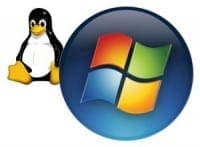 I’ve always been a pro-Linux type of guy. I started using Unix back in 1992 (SunOS(1)) while studying for my software engineering degree. This university use led me to install Linux at home as a dual-boot option along with MS-DOS and Windows 3.1 (with the amazing 800×600 resolution, or the flickering 1024i). Over the years, I’ve worked with various distros such as Slackware(2) and Red Hat(3), and navigated the infinite complexities of the /etc directory and its gazillion cryptic configuration files linked to tons of not-so-clear man pages.
I’ve always been a pro-Linux type of guy. I started using Unix back in 1992 (SunOS(1)) while studying for my software engineering degree. This university use led me to install Linux at home as a dual-boot option along with MS-DOS and Windows 3.1 (with the amazing 800×600 resolution, or the flickering 1024i). Over the years, I’ve worked with various distros such as Slackware(2) and Red Hat(3), and navigated the infinite complexities of the /etc directory and its gazillion cryptic configuration files linked to tons of not-so-clear man pages.
But it was worth every drop of sweat. Linux offered so many more features, security, power to do anything, and a reliability that Windows couldn’t dream of at the time. Linux was a true multitasking OS, it had a firewall, and all the Internet clients and servers one may want or need: POP3, SMTP, HTTP, FTP, and SSH. All of these were virtually impossible to do on MS-DOS or Windows, and I’m not even talking about the various crashes and ridiculous uptimes of the early Microsoft platforms. Since then, and up until a few months ago, it’s always been clear to me: reliability and security on Linux; office work, graphical user interface and leisure on Windows.
So, what happened in the past 15 years? Windows improved and caught up. Microsoft improved the reliability, security and performance of their products. There were a few hiccups (95/98/Millenium, Vista) but overall, recent Windows platforms such as XP and Server 2003, Server 2008, Windows 7 or Server 2008 R2 really deliver:
- My Windows servers now have uptimes on a par with my Linux boxes. Both internal security (permissions, UAC) and external security (exploits, firewalling, TCP/IP stack) are now able to provide great performance and reliability.
- Tons of software vendors and open-source organizations are offering solid and reliable solutions for Internet services on Windows, even ports for traditionally Unix-only daemons (for example, Apache).
- Hardware drivers are a pain to get on Linux because of the various licensing schemes and source code sharing. Windows hardware drivers are so easy to locate, install and update. (On that note, the concept of kernel modules in Linux is great, until you upgrade your kernel for security reasons and end up with non functioning modules.)
- Security fixes and updates are on par for both platforms: they’re delivered quickly and address exploits and breaches accurately.
- I’d rather configure my mail server on an organized graphical user interface than modifying a 20 kB text file of disorganized and sometimes cryptic parameters in vi. I’d also rather download a binary-form software update certified and distributed by the software’s maker than recompile a nightly SVN snapshot because my distro’s company hasn’t updated the package in years.
Let’s face it. Linux’s setup and maintenance is a pain point from a non-guru perspective (and even for a guru, it is time consuming). It is free, sure (kind of): there is no Windows license to pay up front. But the time invested (and often wasted) in administration in the years following the server setup does have a price tag attached, and it can be quite a heavy one. I’m not pretending Windows is better than Linux, but I’ll certainly say Windows is now at least as good as Linux in terms of technology, reliability and performance. And it’s easier to manage.
So why would I bother with Linux servers or appliances? I don’t anymore, and I couldn’t be happier. My Windows-based email security software runs smoothly and has been up and running without a single glitch ever since I started it 4 months ago. I haven’t touched a single configuration text file or init.d script ever since. I have full Remote Desktop and Administrator access to the server itself, and I’m actually able to run it as a VM (which I think is a lot more sexy than a shiny black-box rack mount appliance into which I can’t even telnet or SSH anyway).
What is your own experience? Have you already started migrating Linux-based servers into Windows-based servers? Ever been frustrated by not being able to restart a hung process in that armored black-box appliance (armored even from its own administrator, may I add), and thus had to painfully work through pre-scripted support calls to simply be able to restart a service? Are you surprised by server uptime and robustness in recent Windows systems?
(1) Wikipedia, SunOS (http://en.wikipedia.org/wiki/SunOS)
(2) Wikipedia, Slackware (http://en.wikipedia.org/wiki/Slackware)
(3) Wikipedia, Red Hat (http://en.wikipedia.org/wiki/Red_Hat)



